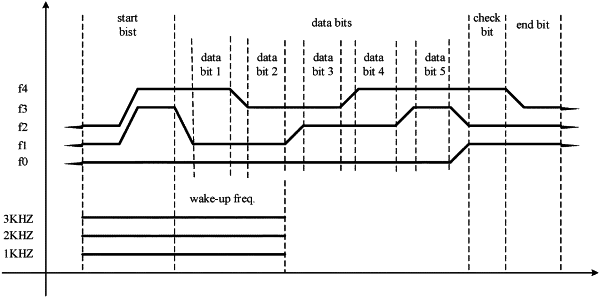| CPC H04B 11/00 (2013.01) | 18 Claims |

|
1. A method for processing ultrasonic waves, applied to coding equipment, comprising:
determining a frequency combination corresponding to target data to be transmitted, the frequency combination comprising at least two different frequencies; and
sending ultrasonic waves of frequencies in the frequency combination within a predetermined duration,
wherein sending the ultrasonic waves of the frequencies in the frequency combination within the predetermined duration comprises:
in response to determining that a number of pieces of target data is greater than or equal to two, acquiring two successive frequency combinations corresponding to two successive pieces of the target data; and
sending ultrasonic waves of the two successive frequency combinations through frequency modulation based on frequencies of a same ordinal logic in the two successive frequency combinations,
wherein the frequencies of the same ordinal logic include a first frequency in one of the two successive frequency combinations, and a second frequency in another of the two successive frequency combinations, and wherein the first frequency and the second frequency have a same order as appeared in their respective frequency combinations,
wherein sending the ultrasonic waves of the two successive frequency combinations through the frequency modulation based on the frequencies of the same ordinal logic in the two successive frequency combinations comprises at least one of:
in response to the frequencies of the same ordinal logic in the two successive frequency combinations being identical, performing splicing processing on the frequencies of the same ordinal logic in the two successive frequency combinations, and sending the ultrasonic waves of frequencies of the two successive frequency combinations subject to splicing processing;
or
in response to the frequencies of the same ordinal logic in the two successive frequency combinations being different, acquiring a shift frequency by performing frequency shift on the frequencies of the same ordinal logic in the two successive frequency combinations, splicing the shift frequency in between the frequencies of the same ordinal logic in the two successive frequency combinations, acquiring the two successive frequency combinations subject to splicing processing, and sending the ultrasonic waves of frequencies of the two successive frequency combinations subject to splicing processing.
|